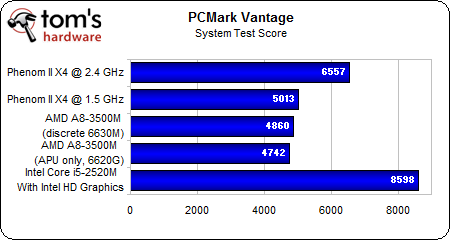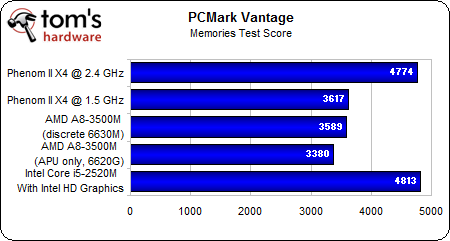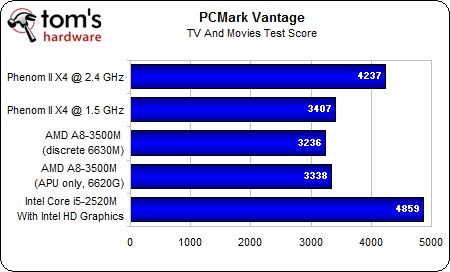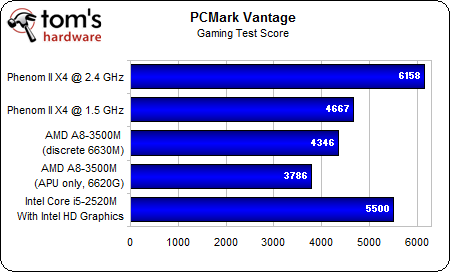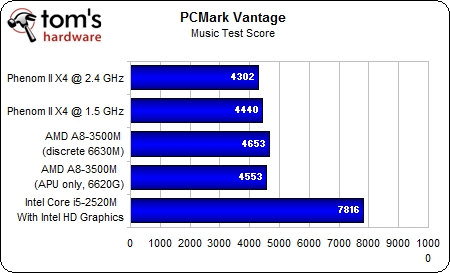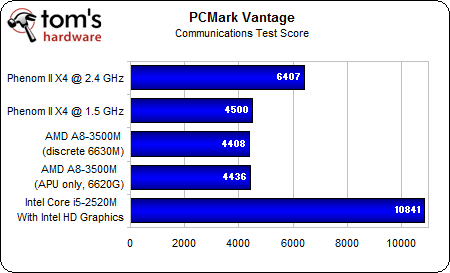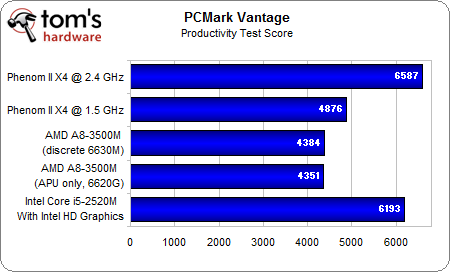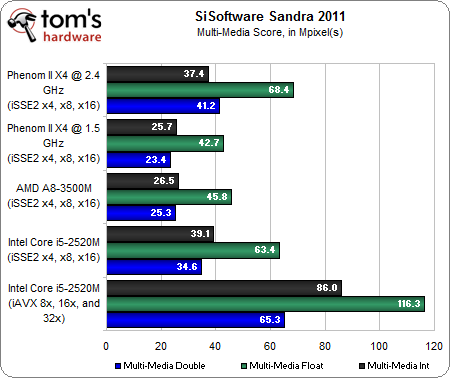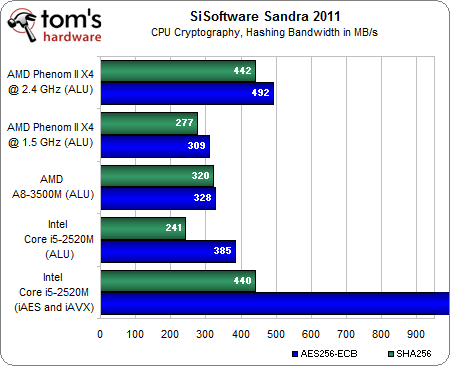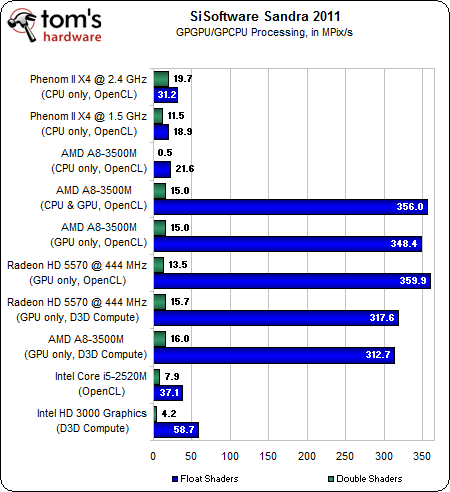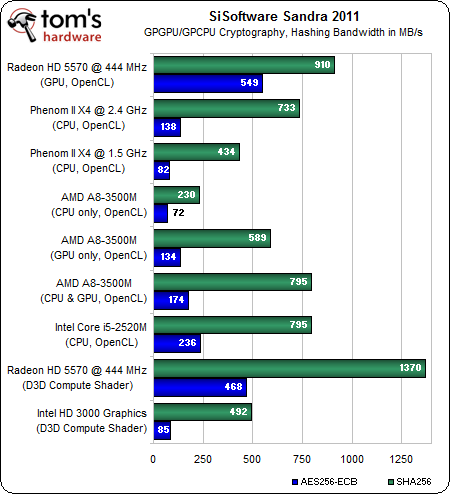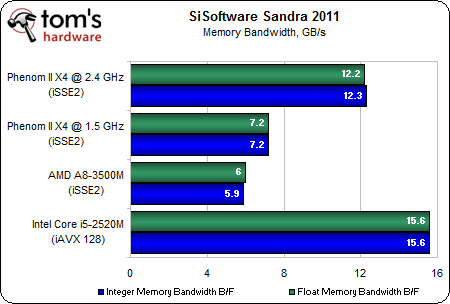The AMD A8-3500M APU Review: Llano Is Unleashed
Code-named Llano, AMD’s first desktop-class APU arrives today. This single-chip combination of the Stars CPU architecture and Radeon graphics brings unique strengths (and weaknesses) to the table, and we’re here to compare them to Intel's Sandy Bridge.
CPU Benchmarks: Synthetic
With the graphics-heavy metrics behind us, let’s break new ground with CPU benchmarks. We’ll start with the synthetics, and PCMark Vantage is first in line:
PCMark’s graphics component is pretty much the only taxing 3D workload in this benchmark, so it’s interesting to see that the A8-3500M appears to perform so closely to the Phenom II X4 at 1.5 GHz. With the GPU unencumbered, we would have hoped there would be room in the chip’s thermal budget for Turbo Core to accelerate the processing cores as close to 2.4 GHz as possible.
Unfortunately, it’s obvious that the 2.4 GHz Phenom II X4 is running significantly faster than the A8-3500M. Even when AMD’s APU is paired with the discrete Radeon HD 6630M to remove the graphics load entirely, Turbo Core doesn’t do much of anything.
To be clear, the A8-3500M has the lowest thermal ceiling in the quad-core Llano notebook-oriented lineup. Still, with the graphics subsystem unloaded, we’re disappointed that Turbo Core appears to be more of a marketing gimmick than a feature with teeth. In comparison, it’s clear when Intel’s Turbo Boost technology is affecting performance—verifiable by the tool Intel provides for monitoring the feature in action.
Intel’s Core i5-2520M is making up for all of its last-place finishes in the game testing, with a sizable lead over the A8-3500M. We do question the applicability of PCMark’s gaming test score after seeing how badly the Sandy Bridge chip was beaten in actual games.
In Sandra’s Arithmetic bench, the A8-3500M performs on par with the 1.5 GHz Phenom II X4. The Core i5-2520M lands closer to AMD’s 2.4 GHz Phenom II, but with iSSE4.2 extensions enabled, Intel’s CPU takes a huge lead.
The situation is the same in the Multimedia benchmark, except that the Core i5 is unleashed with AVX extensions.
Get Tom's Hardware's best news and in-depth reviews, straight to your inbox.
The Cryptography result is similar, except that the Core i5-2520M literally jumps off the charts thanks to its AES-NI support, yielding a 10x performance lead in AES256-ECB hashing bandwidth!
GPGPU/GPCPU Processing
Let’s take a look at OpenCL and Direct3D compute capabilities that can leverage Llano’s CPU and GPU resources at the same time.
Intel only recently released an SDK to support OpenCL, but it’s limited to the CPU and cannot be run on the HD Graphics execution units. Intel’s GPU can run DirectCompute shaders though, so we can test this aspect of its feature set.
The A8-3500M APU demonstrates a colossal advantage over both Intel’s Core i5-2520M OpenCL result and the Intel HD Graphics 3000GPU DirectCompute score. But hold on; let’s look at the GPGPU/CPGPU Cryptography benchmark:
The Core i5-2520M CPU achieves parity with the A8-3500M APU in this discipline, and Intel’s GPU isn’t even contributing here! The bottom two results show Radeon HD 5570 DirectCompute versus Intel HD Graphics 3000 DirectCompute scores.
Finally, let’s consider memory bandwidth. As you can see, the A8-3500M suffers due to its low clock, while a 2400 MHz Phenom II X4 does much better, approaching the Core i5-2520M.
Current page: CPU Benchmarks: Synthetic
Prev Page Game Benchmarks: Anti-Aliasing Next Page CPU Benchmarks: ProductivityDon Woligroski was a former senior hardware editor for Tom's Hardware. He has covered a wide range of PC hardware topics, including CPUs, GPUs, system building, and emerging technologies.
-
fstrthnu AMD is kind of in a fix here, the more enthusiast gamers won't even bother looking at the Llano computers while this is kind of overkill for casual gamers. MAYBE money-pressed college students or something, but most people will just skip this and either buy a regular gaming computer or build their own using one of the guides from this very site! Going for good graphics in cheap desktops is kind of a futile exercise, the people who will care will just get the more expensive stuff anyways. Notebooks are more understandable, but the prices on the decent gaming desktops are just too good for Llano to be very competitive (and also, the CPU portion will be a letdown for the average person. Noticeably slower than the comparable Intel Core i5.)Reply -
stingstang Good job, AMD. You finally made a better cpu/gpu combo than intel in terms of graphics power.Reply
....big win there... -
vz7 After reading the desktop benchmarks on anandtech I can't say I'm impressed. The top of the line a8 3850 manages to scratch the best intel integrated graphics, which doesn't say much. Its CPU power seems to be a toss up with the i3. I think this hardly justifies the +70 premium (over an i3) that you'd have to spend to get it.Reply -
billj214 This APU being somewhat low power and good graphics almost deserves to be in a tablet PC since CPU processing is not critical in tablet PC's and graphics is something that can help with media and games.Reply
Ditto on the "Good Job AMD" definitely on the right track. -
cangelini vz7Do you know when the desktop review for llano will be out?Reply
The NDA is up on the 30th. -
niceview two things:Reply
1) What happened to the Game Charts results for the Radeon HD 5570, when the games were benchmarked? I thought you made a point to say you were going to compare the APU's 6620G with a discrete card (that has the same number of SPs and same clock). So much for that, unless you thought only comparing the two with a synthetic test was enough. Oh well. Tom's can be such a tease!
2) I'm just a little disappointed that the APU's graphics power was not able to double Intel's.... Under the best of circumstances, AMD's latest integrated graphics came close to being twice as fast, but i guess that is ok since we are not playing horseshoes. I just thought it would be nice if it had made a nice even doubling, or more. Now, i'm worried IVY BRIDGE will beat it.... -
niceview sorry, i guess that should be:Reply
we ARE playing horseshoes...
and i have to give credit where credit is due: props to AMD for almost doubling Intel's HD Graphics in the integrated space....
